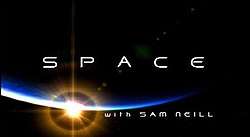Space (2001 TV series)
Space (Hyperspace in the United States) is a 2001 BBC documentary which ran for six episodes covering a number of topics in relation to outer space. The series is hosted and narrated by actor Sam Neill.
| Space | |
|---|---|
 The Ultimate Journey Beyond Any Known Universe | |
| Also known as | Hyperspace |
| Genre | Documentary |
| Narrated by | Sam Neill |
| Theme music composer | Ty Unwin |
| Country of origin | United Kingdom |
| Original language(s) | English |
| No. of episodes | 6 |
| Production | |
| Executive producer(s) | Philip Dolling & Emma Swain |
| Producer(s) | Luke Campbell & Jeremy Turner |
| Running time | 206 minutes (6 episodes) |
| Release | |
| Picture format | 1.78:1 |
| Original release | 22 July – 26 August 2001 |
Episodes
| # | Title | Original Air Date | |
|---|---|---|---|
| 1 | "Star Stuff" | 22 July 2001 | |
| The first episode covers the origins of life and how everything is produced by the process in which stars burn their fuel. | |||
| 2 | "Staying Alive" | 29 July 2001 | |
| This episode analyses the chances of Earth being destroyed by a black hole or asteroid. | |||
| 3 | "Black Holes" | 5 August 2001 | |
| Episode three looks at how black holes are formed and how they behave, with potential to destroy the solar system. | |||
| 4 | "Are We Alone?" | 12 August 2001 | |
| Number four looks for potential homes of extraterrestrial life and the chances that humans could make contact. | |||
| 5 | "New Worlds" | 19 August 2001 | |
| The fifth episode covers the possibility of colonising and terraforming planets both in our solar system and beyond into deep space. | |||
| 6 | "Boldly Go" | 26 August 2001 | |
| The final episode looks at the technologies that are being developed to further enable our venture into space. | |||
DVD releases
- The series was released on region 2 DVD in 2001 by BBC Video.
- In 2002, the series was released in the United States on region 1 DVD (under the alternate title Hyperspace), also by BBC Video.
gollark: Well, no, that won't run, because it's programmed for x86 CPUs using Windows APIs.
gollark: Your definition of software is a wrong, surface-level view.
gollark: I say "programs" because there are a few background daemons running for various random tasks.
gollark: This is software. It's programs running within an (emulated) CC computer.
gollark: I don't have Minecraft open, RAM use and all, but I can show you a screenshot from an *emulator*.
This article is issued from Wikipedia. The text is licensed under Creative Commons - Attribution - Sharealike. Additional terms may apply for the media files.